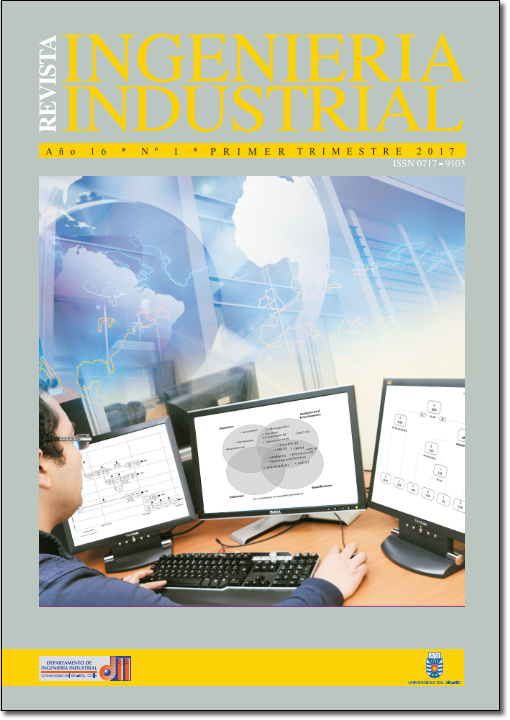STRATEGIES FOR REDUCING THE PROCESSES VARIABILITY IN THE FOOTWEAR INDUSTRY
DOI:
https://doi.org/10.22320/s07179103/2017.03Palabras clave:
Statistical Process Control, Synthetics laminates, Process capability, Analysis of cause and effectResumen
This article presents a case study of a Brazilian company, operating in the footwear sector, located in Parobé city, in the Valley of Paranhana, in the state of Rio Grande do Sul. The process analyzed showed high failure rates of manufactured batches and by quality analysis tools, the Statistical Process Control tools were applied to analyze the variability. The tools applied were the control charts, process capacity and capability analysis, histogram, Pareto chart and cause and effect analysis. The main results of the study were the reduction of the rejection indices of the process to zero and improvement in the capacity index from 0,424 to 1,52, demonstrating the reduction of the sources of variation of the production process and reaching the objectives The research. This research can be used by academics and professionals to improve the competitive performance of footwear companies.
Descargas
Citas
ASSINTECAL – Associação brasileira de empresas de componentes para couro, calçados e artefatos. [online]. 2017. [cit. 2016-05-10]. Disponível em: /www.assintecal.org.br>.
ABICALÇADOS - Associação brasileira das indústrias de calçados. [online]. 2017. [cit. 2016- 05-15]. Disponível em: /www.abicalcados.com.br/relatorioanual/.
BRACKE, S. and BACKES, B. Multidimensional analysis of manufacturing processes: process capability within the case study shape drill manufacturing. IFAC, 2015, 48 (3), 2380–2386.
FARIAS, J. P. da S. Avaliação da Satisfação do cliente: Uma experiência com a empresa
Raboni calçados. Universidade estadual da Paraíba, campus VII, Centro de Ciência Exatas e Sociais Aplicadas, Paraíba, 2012.
GEJDOS, P. Continuous Quality Improvement by Statistical Process Control. Procedia Economics and Finance, 2015, 34, 565-572.
GOULART L.E.T and BERNEGOZZI R.P. O uso das ferramentas da qualidade na melhoria de processos produtivos. XVI International Conference on Industrial Engineering and operations Management: ICIEOM, São Carlos, 2010.
MANCUSO, A.C.B and WERNER, Liane. Estudo dos métodos de previsão de demanda aplicado em uma empresa de auditorias médicas. Revista Ingeniería Industrial, 2014, 13 (1), 99-111.
MIGUEL, P. C and FLEURY, A.C. Metodologia de pesquisa em engenharia de produção e gestão de operações. 2. Ed. Rio de Janeiro: Elsevier, 2010. ISBN 978-8535248913.
MONTGOMERY, D.C. Estatística Aplicada e Probabilidade para Engenheiros. 4. Ed. Rio De Janeiro: LTC, 2009. ISBN 978-8521632412.
MONTGOMERY, D.C.; RUNGER, G.C.; HUBELE, N.F. Estatística aplicada à engenharia. 2. ed. Rio de Janeiro: LTC, 2004. ISBN 978-8521613985.
MÜLLER, P.E.; ROSA, A.; KRUMMENAUER, L.G.; PACHECO, D.A.J.; JUNG, C.F and CATEN, C.S. Contribuições do CEP para a melhoria do desempenho do pós-vendas na indústria calçadista. Revista Ingenieria Industrial, 2015, 14 (1), 51-66.
PALADINI, P.E. Gestão da qualidade: Teoria e Prática. 3 Ed. São Paulo: Atlas, 2000. ISBN 978-8522471157.
PORTERO, P.P. Avaliação instrumental da correspondência de cor de resinas compostas em função de escalas de referência, tonalidade, composição e espessura. Dissertação de Mestrado, UNESP – Universidade Estadual Paulista de Araraquara, Araraquara, 2010.
Descargas
Publicado
Número
Sección
Licencia

Esta obra está bajo una licencia internacional Creative Commons Atribución 4.0.
Revista Ingeniería Industrial by Revista Ingeniería Industrial is licensed under a Creative Commons Reconocimiento 4.0 Internacional License. Creado a partir de la obra en revistas.ubiobio.cl/index.php/RI/. Puede hallar permisos más allá de los concedidos con esta licencia en http://revistas.ubiobio.cl/index.php/RI/about/

















